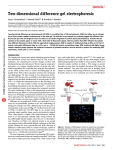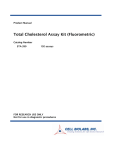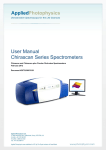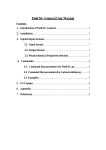Download Using circular dichroism collected as a function
Transcript
PROTOCOL Using circular dichroism collected as a function of temperature to determine the thermodynamics of protein unfolding and binding interactions Norma J Greenfield Published online 29 December 2006; doi:10.1038/nprot.2006.204 Circular dichroism (CD) is an excellent spectroscopic technique for following the unfolding and folding of proteins as a function of temperature. One of its principal applications is to determine the effects of mutations and ligands on protein and polypeptide stability. If the change in CD as a function of temperature is reversible, analysis of the data may be used to determined the van’t Hoff enthalpy and entropy of unfolding, the midpoint of the unfolding transition and the free energy of unfolding. Binding constants of protein-protein and protein-ligand interactions may also be estimated from the unfolding curves. Analysis of CD spectra obtained as a function of temperature is also useful to determine whether a protein has unfolding intermediates. Measurement of the spectra of five folded proteins and their unfolding curves at a single wavelength requires B8 h. INTRODUCTION There are numerous reviews on the theory and use of CD1–7 as well as a website with animated graphics http://www.enzim.hu/~szia/ cddemo/, which illustrates the production of circularly polarized light, the CD of optically active molecules, and how passing planepolarized light through an asymmetric molecule results in the production of elliptically polarized light. An introduction to CD and a description of how to estimate the secondary structure of a protein from its CD spectrum are in the first protocol in this series8. Briefly, CD is the difference between the absorption of left-handed (eR) and right-handed (eL) circularly polarized light. CD is reported either in units of De, the difference in absorbance of eR and eL by an asymmetric molecule, or in degrees ellipticity, which is defined as the angle whose tangent is the ratio of the minor to the major axis of the ellipse [y], the molar ellipticity in deg cm2 dmol–1 ¼ 3,298DE. For illustrations of the phenomena of CD see Beychok2. When proteins are folded they often have highly asymmetric secondary structural elements, such as a-helices and b-pleated sheets (b-helices), which have characteristic CD spectra (Fig. 1). The spectra of some highly helical model proteins are shown in Figure 2. When proteins unfold they lose these highly ordered structures, and the CD bands change. Some proteins tend to unfold completely and their unfolded spectrum resembles that of a mixture of short polypeptides (e.g., see the spectrum of unfolded collagen, Fig. 1). Other proteins and polypeptides only partially unfold and may have considerable residual a-helical content in a ‘moltenglobule state’9–13. The changes in CD as a function of temperature, at characteristic wavelengths, can be used to determine the thermodynamics of unfolding (or more precisely change of state), that is, the van’t Hoff enthalpy (DH) and entropy (DS) of unfolding, the midpoint of the unfolding transition (TM) and the free energy (DG) of on folding. If the apparent TM of unfolding is changed as a function of protein concentration or perturbed by changes in salt or pH, the heat capacity change of unfolding (DCp) can also be estimated from CD data. In addition, analysis of CD spectra obtained as a function of temperature may also be useful in determining whether a protein has unfolding or folding intermediates. The thermodynamics of protein unfolding can be investigated by either monitoring the ellipticity at a single wavelength or collecting complete spectra as a function of temperature. Two additional protocols on the use of CD to study protein folding cover the determination of the free energy of folding and binding constants from CD data collected as a function of denaturants, osmolytes or ligands14 and determination of the kinetics of folding from CD data collected as a function of time15. Characterization of unfolding by following the change in ellipticity at a single wavelength as a function of temperature. When the CD of a protein and polypeptide or other asymmetric polymer such as a polynucleotide or polysaccharide changes as a 80 60 [θ] × 10–3 deg cm2 dmol–1 © 2006 Nature Publishing Group http://www.nature.com/natureprotocols Department of Neuroscience and Cell Biology, Robert Wood Johnson Medical School, Piscataway, New Jersey 08854-5635, USA. Correspondence should be addressed to N.J.G. ([email protected]). 40 1 α-helix 2 antiparallel β 3 extended 4 collagen (triple helix) 5 collagen (denatured) 20 0 5 –20 2 1 –40 3 4 –60 190 200 210 220 230 240 250 Wavelength, nm Figure 1 | CD spectra of polypeptides and proteins with some representative secondary structures. CD spectra of poly-L-lysine in the (1) a-helical (black) and (2) antiparallel b-sheet (red) conformations at pH 11.1, and (3) extended conformation at pH 5.7 (green)44, and placental collagen in its (4) native triple-helical (blue) and (5) denatured (cyan) forms45. Note that the extended conformation of poly-L-lysine was original described as a ‘‘random coil’’, but its spectrum is similar to the conformation of poly-L-proline II46,47, which forms an extended left-handed helix. NATURE PROTOCOLS | VOL.1 NO.6 | 2006 | 2527 a 300 1 CTD 2 NTD 200 Millidegrees Figure 2 | Spectra of unbound tropomyosin and troponin model proteins and protein-protein complexes. (a) Raw data. (b) Mean residue ellipticity. CTD is a peptide containing residues 251–284 of rat striated tropomyosin with GCG at the N terminus. The peptides are cross-linked by a disulfide bond40. NTD is a model protein of the N-terminal domain of tropomyosin containing residues 1–14 of rat striated a-tropomyosin and the last 18 residues of the yeast transcription factor, GCN4. The peptide is N-acetylated39,43. TNT70–170I79N is residues 70–170 of human cardiac troponin with the mutation I79N and glycine at the N terminus43. The protein concentrations were all 17.5 mM in 10 mM potassium phosphate, pH 6.5. Data were collected in cells with 1-mm path lengths. 100 0 –100 –200 200 220 240 © 2006 Nature Publishing Group http://www.nature.com/natureprotocols Wavelength, nm function of temperature, the change can be used to analyze the thermodynamics of unfolding or folding. In the simplest case a molecule undergoes an unfolding transition between two states: folded, F, and unfolded, U. At any temperature, T, the constant of folding, K, is: K ¼ ½F=½U ð1Þ where [F] and [U] are the concentrations of the folded and unfolded forms, respectively. The free energy of folding is: DG ¼ RTlnK ð2Þ where R is the gas constant (1.98 cal mol–1) and T is the absolute temperature (Kelvin). The fraction folded at any temperature is a. a ¼ ½F=ð½F+½UÞ ð3Þ a ¼ ðyt yU Þ=ðyF yU Þ ð4Þ where yt is the observed ellipticity at any temperature, yF is the ellipticity of the fully folded form and yU is the ellipticity of the unfolded form. To fit the change of CD at a single wavelength as a function of temperature, T (Kelvin), one uses the Gibbs-Helmholtz equation that describes the folding as a function of temperature. If one is following the unfolding of a monomer, the following equations (7–10) are fitted: DG ¼ DHð1 T=TM Þ DCp ððTM TÞ+TlnðT=TM ÞÞ ð5Þ K ¼ expðDG=ðRTÞÞ ð6Þ a ¼ K=ð1+KÞ ð7Þ ½yt ¼ að½yF ½yU Þ+½yU ð8Þ TM is the temperature at which a ¼ 0.5, and DCp is the change in heat capacity going from the folded to the unfolded state. DCp is usually set at 0 for the initial calculations of the thermodynamics of folding of a monomeric protein. Initial values of DH, TM, [y]F and [y]U are estimated and used as initial parameters for nonlinear least squares fitting routines. The values giving the best fit to the raw data are found using the fitting procedures found in the commercial curve fitting programs described in MATERIALS. One can fit the unfolding of homoand heterodimers and trimers using similar equations16,17. If a protein exhibits multiple unfolding transitions, CD data can be fitted by the sum of multiple transitions. 2528 | VOL.1 NO.6 | 2006 | NATURE PROTOCOLS 260 b 80 [θ] × 10–3 deg cm2 dmol–1 PROTOCOL 60 40 20 0 –20 –40 200 220 240 260 Wavelength, nm Occasionally there are regions in the curves of ellipticity as a function of temperature, preceding or following the unfolding transitions, where the ellipticity shows a change that is almost linear as a function of temperature. One can add linear18 or parabolic19 corrections to the equations to subtract these contributions. The entropy of unfolding, DS, at the temperature at which K ¼ 1, can be calculated using the relationship: DG ¼ DH – TDS. Equations for fitting unfolding/folding curves in SigmaPlot format are available at http://www2.umdnj.edu/cdrwjweb and in Supplementary Equations. DCp is difficult to estimate from CD measurements for a monomer, because there is insufficient information in a single unfolding curve, obtained under one set of conditions, to estimate this parameter19. For multimers DCp can be determined from global analysis of unfolding as a function of both concentration and temperature20–24. If the apparent TM of unfolding (a ¼ 0.5) of a monomer changes as a function of pH or other perturbant, the DCp of unfolding can be evaluated from the slope of the plot of the enthalpy at the apparent TM, obtained under each condition, as a function of the TM (Kelvin). This value can then be used as fixed parameter for determining the enthalpy and TM of unfolding using equations 5–8. Direct fitting of unfolding curves is easy for monomers, dimers and trimers (Fig. 3a), but it is difficult for higher order multimers. An alternative method is to determine the midpoints of the unfolding curves by taking derivatives of the spectra (Fig. 3b) and to determine the enthalpy of unfolding using the van’t Hoff equation (Fig. 3c). At two different temperatures, T1 and T2: lnðK2 =K1 Þ ¼ DH=Rð1=T1 1=T2 Þ ð9Þ where K2 and K1 are the folding constants at T2 and T1 , respectively. To determine the enthalpy of unfolding from van’t Hoff analysis, the natural logarithm (ln) of the folding constant K is plotted as a function of 1/T, where T is the absolute temperature (Kelvin). The data are truncated to the region around the region giving a linear curve with the highest slope. The enthalpy of unfolding equals the slope of the line times the gas constant, R, which is equal to 1.98 cal mol–1. Characterizing the unfolding of a protein by examining spectra as a function of temperature. The information about the unfolding pathway is greatly increased by collecting full spectra as a function of temperature. The set of spectra can then be deconvoluted using either the convex constraint algorithm (CCA)25–27 or singular value decomposition (SVD)28–31 to obtain information about the number of folded states contributing to the set of spectra. The change in the fraction of each basis spectrum determined using PROTOCOL © 2006 Nature Publishing Group http://www.nature.com/natureprotocols the CCA, contributing to the total CD as a function of temperature, may also be used to estimate the thermodynamics of unfolding. Comparison with related methods. When the unfolding of a protein is reversible and two-state and there is only a single unfolding transition, the thermodynamic parameters evaluated by CD are almost identical to those that can be estimated using scanning calorimetry32,33. When there are multiple unfolding transitions, CD and scanning calorimetry will usually give the same total enthalpy of unfolding, but the value of the enthalpy of the individual transitions may vary because of the difficulty of separating overlapping transitions. For an example of the unfolding of tropomyosin and tropomyosin mutants, which have closely spaced multiple reversible unfolding transitions, see the work of Singh and Hitchcock-DeGregori34. CD and other spectroscopic measurements, such as measuring changes in absorption and fluorescence, will give similar results if the unfolding of the protein or polypeptide represents a two-state transition between totally folded and unfolded forms. Different methods may give varying results if there are multiple transitions. For example, if a region with aromatic chromophores loses its tertiary structure packing before the molecule loses all of its secondary structure, examining the unfolding by looking at the CD of the aromatic region, or the fluorescence or aromatic groups, will give thermodynamic parameters different from those obtained by examining the CD of backbone a-helices by following the unfolding at 222 nm20,35. For the most accurate determination of protein unfolding thermodynamics and pathways, it is always preferable to use multiple methods. Applications. Measuring CD as a function of temperature can be used to determine: the effects of mutations on protein stability, as well as the binding constants of interacting proteins and proteinligand complexes. CD can be used to determine whether the TM or slope of a transition changes when mutations are present. If the unfolding is reversible, true thermodynamic parameters can be obtained. Even if the unfolding is irreversible, because the protein aggregates at high temperature, the method can still give information about relative stability, especially if the same apparent unfolding parameters are obtained at different rates of heating, showing that kinetics of aggregation are not perturbing the results. If two proteins bind to each other only when they are folded, and the protein complex unfolds cooperatively and reversibly, one can use the change in stability upon binding to measure the binding constant. In the simplest case both proteins (e.g., X and Y) are monomers, [XF] and [YF] are the concentrations of folded X and Yand [XU] and [YU] are the concentrations of unfolded X and Y, respectively. 1. The constant of folding of protein X is: ð10Þ kFX ¼ ½XF =½XU 2. The constant of folding of protein Y is: kFY ¼ ½YF =½YU ð11Þ 3. The constant of folding of the dimer is: kFXY ¼ ½XYF =½XU ½YU ð12Þ 4. The association constant: KA ¼ ½XYF =½XF ½YF ð13Þ 5. Making the substitutions KA ¼ kFXY =kFX kFY ð14Þ To determine the association constant: 1. Determine the DH and DS of folding of the individual monomers X and Y and the stability of the dimer XY by following their ellipticity as a function of temperature or denaturant. 2. Calculate the free energy of folding at any temperature using: DG ¼ DH TDS ð15Þ 3. Determine the folding constant from the relationship: ð16Þ KF ¼ expðDG=RTÞ 4. Divide the KF of folding of the dimer by the KF values of folding of the two monomers to obtain the binding constant for the dimer formation. If a ligand binds to a protein only when it is folded, the increase in stability of the complex as compared with the free protein can be used to estimate the binding constant. If the changes in enthalpy of folding upon binding are small, the binding constant can be evaluated using the equation: DTM ¼ ðTT0 R=DHÞ ln ð1+K½LÞ ð17Þ where DTM is the change in the midpoint of the thermal denaturation curve, T and T0 are the TM values in the present and absence of ligand, DH is the enthalpy of unfolding of the protein in the presence of the ligand, K is the equilibrium for the binding of the ligand to the folded protein, [L] is the free concentration of ligand and R is the gas constant18,36,37. Experimental design. It is difficult to give a single protocol for collecting data as a function of temperature, because the various CD instruments use different methods of controlling temperature. In some instruments temperature change is steady as a function of time (this is called a temperature ramp). With other instruments one sets the desired temperature increment and equilibration time at each point. Some manufacturers have sample compartments where measurements can be made on multiple samples at each temperature. The machines also all have different methods of programming the collection of data. Some allow one to make macros to collect spectra as a function of temperatures. Consult the manufacturer for details of individual instruments. The steps described in the procedure for collecting data at a single wavelength, and for collecting spectra as a function of wavelength have been used for data collection on Aviv Model 62D, Aviv Model 202 and Aviv Model 215 instruments equipped with a temperatureregulated five-compartment cell holder. Preliminary experiments. Many proteins equilibrate slowly. For accurate measurements of thermodynamic parameters, it is important to set the equilibration time long enough to allow full equilibration. Preliminary experiments should be performed to determine how much time is required for a protein to fold and unfold at selected temperatures and to insure that the protein will be fully unfolded at the highest temperature studied. It is suggested to take preliminary spectra at 5, 10, 25, 37, 50 and 70 deg and then take spectra at 50, 37, 25 and 10 deg to determine whether the protein refolds8. CD and all other spectroscopic techniques can only be used to obtain true thermodynamic properties if the unfolding and NATURE PROTOCOLS | VOL.1 NO.6 | 2006 | 2529 PROTOCOL folding of a protein is reversible and curves obtained when the sample is heated (e.g., from 10 to 70 1C) and cooled (from 70 to 10 1C) are identical. Collagen and related proteins fold and unfold very slowly, and for accurate determination of the enthalpy and TM values of folding, unfolding experiments are set to run overnight or even longer periods of time. © 2006 Nature Publishing Group http://www.nature.com/natureprotocols MATERIALS REAGENT SETUP Five to six protein samples The number depends on multi-cell holder rotor capacity. For example, one could use a single protein at different or replicate concentrations; individual proteins containing different mutations; individual proteins that interact and mixtures of interacting proteins; free proteins and proteins with various ligands added; the same protein concentration dissolved in buffers with different pH values. The preparations of protein samples, determination of protein concentration and buffers suitable for CD have been discussed8. The samples should be preincubated at the desired starting temperature to ascertain that the proteins are fully folded. Most globular proteins that are active at physiological temperature will fold fully at 25 1C within minutes, but collagen-like triple helices can take several days to fold. If the study involves short protein fragments or peptides about which little is known, they should be folded on ice overnight. Folding conditions have been described in greater detail elsewhere8. To retard evaporation, melts can be done in cuvettes with Teflon stoppers. Alternatively, a drop of mineral oil may be carefully placed on top of the protein solutions to prevent evaporation. EQUIPMENT Sources of CD instruments and cuvettes have been described elsewhere8. EQUIPMENT SETUP Procedures for starting CD instruments have been detailed elsewhere8. Make sure that the instrument is flushed with nitrogen before firing the lamp and that circulating water baths (if needed for cooling the lamp or acting as a heat trap for the temperature controllers) are activated before the CD software is started. Software A commercial graphic program that allows user-defined nonlinear least squares curve fitting. Most of the commonly available commercial programs use the Levenberg-Marquardt algorithm38 for fitting curves to nonlinear equations. Graphic packages include: GraphPad, http://www.graphpad. com/; Psi-Plot, http://www.polysoftware.com/aboutpsi.htm; Origin, http:// www.originlab.com; and SigmaPlot, http://www.systat.com. Some of these programs (e.g., SigmaPlot) allow global fits to multiple parameters. Noncommercial software is available to analyze the spectra of proteins obtained as a function of temperature using the CCA http://www2.chem.elte. hu/protein/programs/cca/ or http://www2.umdnj.edu/cdrwjweb/. Commercial software that can deconvolute CD spectra using SVD is also available from some CD manufacturers (e.g., Olis and Applied Photophysics) and is available as a stand-alone application from Olis (http://www.olisweb.com/software/ svd.php). PROCEDURE Data collection at a single wavelength in one direction TIMING 7–8 h for collecting initial baselines and spectra and performing an unfolding study in one direction, 12–14 h for unfolding and refolding. 1| Set the desired temperature to start the measurements (0). In this and the following steps, suggested values are in parentheses. 2| Take initial spectra of the protein samples to determine the wavelengths that have maximal ellipticity. For example, proteins with high helical content have peaks at 222, 208 and 193 nm. Unfolding studies are usually performed at the 222-nm peak, because data at higher wavelengths usually have lower absorption and higher signal-to-noise ratio. ? TROUBLESHOOTING 3| Set the desired wavelength (e.g., 222 nm for proteins with a high content of a-helices, 218 nm for proteins with a high content of b-structure, or 225 or 200 nm for collagen-like peptides). ? TROUBLESHOOTING 4| Set the sample changer or rotor for the desired number of samples (5). 5| Set the desired temperature range (0 1C to 70 1C). To take spectra of the unfolded proteins after the melt, set the temperature to remain at the final temperature after the experiment is completed. If an unknown protein is under study and the protein is not fully unfolded by 70 1C, one can collect a second set of data between 70 1C and 90 1C and combine the data sets. To check whether unfolding is reversible, set the machine to collect the reverse scan from 70 deg to 0 deg using a negative increment at the completion of the run. m CRITICAL STEP Do not set the upper temperature 490 1C, because prolonged use at high temperature may damage the temperature controller. 6| Set the desired temperature interval (0.2 1C). 7| Set the equilibration time at each point (0.2 min). 8| Set the temperature tolerance (0.15 1C). 9| Set the number of seconds to collect data at each point (5 s) and the time constant for machine response (100 ms). 10| Set the rate of heating (5 deg min1). 11| Start the data collection. 12| Periodically examine the progress of unfolding by looking at the unfolding curves. ? TROUBLESHOOTING 2530 | VOL.1 NO.6 | 2006 | NATURE PROTOCOLS PROTOCOL 13| Save the data in columns of ellipticity (y) versus temperature (x). m CRITICAL STEP Make sure the data are saved on the hard drive or other permanent medium, because data will be lost if the machine is turned off or the power fails before the data are saved. ’ PAUSE POINT The data collection can be ended here. If the machine has not been automatically set to return to the initial temperature, make sure to cool the machine before removing the samples to prevent burns and to allow removal of cell stoppers, which tend to stick at elevated temperatures because of the difference in the expansion of the Teflon stoppers and quartz cell. If the stoppers stick in the cuvettes, plunging them upside down in an ice bath will usually loosen them © 2006 Nature Publishing Group http://www.nature.com/natureprotocols Data analysis TIMING 8 h 14| Import the data into a Graphics program with columns of ellipticity versus temperature, and plot the curves. 15| If data has been collected as a function of both heating and cooling, plot the data sets on the same graph and see whether they overlay one another. ? TROUBLESHOOTING 16| If the data show only one folding transition, initially fit the data using curves describing the unfolding of a monomer using equations 7–10 described earlier. Set the initial values for the ellipticity of the folded and unfolded proteins by examining the graphs. Estimate the TM from the midpoint between the starting and ending ellipticity values. Initially set the estimated enthalpy to between –20,000 and –50,000 cal mol–1 and the value of DCp to 0. If there are multiple transitions the data can be initially fitted by the sum of two or more transitions. The number of transitions and their midpoints can be estimated by taking the first derivative of the folding curve. The maxima will be at the midpoints of the folding transitions. 17| Run the curve fitting routine, and plot the fitted curve to the raw data. If the agreement is good you are finished. If the fits are good around the midpoint of the transition but deviate at the ends, include linear corrections for pre- and post-transitions (see the sample fitting curves in Supplementary Equations). ? TROUBLESHOOTING 18| If the same protein gives different calculated values for the TM that increase as a function of concentration, try fitting the data by equations that assume that the protein is forming dimers or trimers and evaluate the TM at K ¼ 1 (see Supplementary Equations). If the correct oligomerization state is assumed, the calculated TM at K ¼ 1 should be independent of protein concentration. ? TROUBLESHOOTING 19| If the protein or protein complex is a dimer or trimer, one can fit the data globally to determine the TM at K ¼ 1, and DH and DCp of folding by performing Option A or Option B. To follow Option A, convert the data to mean residue ellipticity8, and fit the data to folding equations using three variables, wherein the independent variables are temperature and protein concentration and the dependent variable is mean residue ellipticity (e.g., column 1, temperature; column 2, protein concentration; column 3, mean residue ellipticity). Equations for performing global fits are in Supplementary Equations. To follow Option B, fit the curves collected at each concentration individually using the equations for unfolding of a monomer with corrections for any pre- or post-transition linear changes in ellipticity. Use the parameters determined for the ellipticities of the fully folded and unfolded proteins and any linear changes as a function of temperature to convert the data to a scale of 1 to 0, where 1 is the fully folded protein and 0 is the fully unfolded protein. Then fit the data globally, where the independent variables are temperature and protein concentration and the dependent variable is the fraction folded. Collecting spectra as a function of temperature TIMING 6–24 h 20| Program the CD instrument to collect spectra as a function of temperature if the machine has a macro writing program using the following parameters. If the machine does not run macros, set the same parameters to collect the spectra, but you will have to change the temperature manually. 21| Set the number of sample compartments used (5). 22| Set the equilibration time at each temperature (2–5 min). 23| Set starting temperature (0 1C). 24| Set the temperature interval (5 deg) and number of repeat increments, or set each temperature increment manually to take points more closely spaced where the ellipticity changes rapidly as a function of temperature (determined from Steps 12–14). 25| Set the wavelength range for data collection and the number of repeats8. NATURE PROTOCOLS | VOL.1 NO.6 | 2006 | 2531 PROTOCOL 26| Save the macro, for example, with the name ‘tempscan’. 27| Run the macro ‘tempscan’ or manually collect data at each desired temperature. ? TROUBLESHOOTING 28| Save the data. 29| Import the data into a graphics program or spreadsheet. For use with the CCA the first column should be the wavelengths, and the following columns should have the ellipticity values collected at each temperature. Save the file in a comma-delineated format with a name that is no longer than eight characters with an extension of no more than three (e.g., ‘data.dat’ for analyzing the data using the CCA algorithm. Make a different set for each protein sample. © 2006 Nature Publishing Group http://www.nature.com/natureprotocols 30| To combine data sets collected using different protein concentrations, convert the data to mean residue ellipticity8. 31| Analyze the data using the CCA or SVD to determine the number of basis sets need to reconstruct the data. Detailed instructions for use of the CCA program are in Supplementary Tutorial. If only two basis sets are needed to reconstruct the entire set the protein does not have a folding intermediate that is detectable by CD. ? TROUBLESHOOTING ? TROUBLESHOOTING Troubleshooting advice can be found in Table 1. TABLE 1 | Troubleshooting table. Step 2 Problem The CD spectra have very low ellipticity Solution Check the protein concentration8 3 The signal-to-noise ratio is very low Try opening the slit width to 2 nm, because the exact wavelength is not critical. Try increasing the time of data collection. Signal-tonoise ratio increases as the square root of the signal averaging time 12 The samples precipitate when heated Try using a different buffer or include stabilizing agents such as low concentrations of glycerol 15 The samples refold to give the same spectra as the starting material, but the unfolding and refolding curves are displaced from each other The samples are not at thermal equilibrium during the measurements. Try increasing the equilibration time 17 The curve of ellipticity as a function of temperature appears to have a typical sigmoidal shape, but none of the folding equations fit the data and the error of the fit is large Make sure that the initial parameters are close to the actual values of the data and that the correct units are used for the initial estimates of the ellipticity of the folded and unfolded protein (e.g., millidegrees or mean residue ellipticity). Make sure the initial estimate of the TM of folding is close to the midpoint of the transition. If this does not work, try increasing or decreasing the initial estimates of the enthalpy of folding 18 The calculated TM values for different concentrations of protein are not close to each other, even when the data are modeled to fit the dissociation of dimers or trimers Determine the oligomerization state of the protein using independent methods such as gel filtration or ultracentrifugation, and use the van’t Hoff equation to determine the thermodynamic parameters 27 The macro does not work properly Check the user’s manual to make sure you have programmed the machine properly. Usually machines will have sample macros. Try to program a single temperature step with using only one or two samples 31 When the spectra are deconvoluted using the CCA some basis curves only contribute to a spectrum obtained at a single temperature If a spectrum is noisy and has outlying points, the CCA will identify the spectrum as a unique basis set. Try removing the spectrum from the data set When the spectra are analyzed using the CCA, some of the curves have very similar shapes but are displaced from each other The CD spectra of the cells may change as a function of temperature, leading to shifts in the baseline. Obtain spectra of the cuvettes filled with water as a function of temperature, and correct the individual data set for the contribution of the cells If the spectra of the folded and unfolded proteins have maxima (nodes) that are mutually identical, SVD of the solution may be ‘‘singular’’ and only one spectrum will be deconvoluted. When the data are deconvoluted using SVD, although it is clear that there are more than two states, only one principal component is resolved 2532 | VOL.1 NO.6 | 2006 | NATURE PROTOCOLS PROTOCOL b 0 Ln (K) Millidegrees 4 30 3 20 2 1 CTD 2 NTD 3 TnT(I79N)70–170 Mix NTD + CTD Mix NTD + CTD + TnT(I79N)70–170 Add curves 1 and 2 Add curves 1, 2 and 3 –40 –60 –80 10 1 –100 –120 –140 © 2006 Nature Publishing Group http://www.nature.com/natureprotocols c 40 –20 ∆θ/∆T a 0 10 20 30 40 50 60 70 Temperature, °C 0 0 –10 –1 3.10 3.20 3.30 3.40 3.50 1/T (Kelvin) 0 10 20 30 40 50 60 70 Temperature, °C Figure 3 | Typical curves of ellipticity as a function of temperature used to determine the thermodynamics of folding. In all the panels the proteins, symbols and conditions are the same as Figure 2. (a) Changes in ellipticity of tropomyosin and troponin model proteins and protein complexes as a function of temperature. The raw data are fitted with equations for the unfolding of monomers (CTD and TnT70–170I79N), a dimer (NTD), a heterotrimer (NTD-CTD complex) and a generic hyperbolic curve (CTD-NTD-TnT70–170I79N complex), respectively. (b) Van’t Hoff plots of the data in a. (c) The first derivatives of the curves in a. The maxima correspond to the midpoints (TM values) of the unfolding and folding curves. ANTICIPATED RESULTS Melts at a single wavelength Analysis of CD spectra of proteins as a function of temperature should allow determination of the thermodynamics of folding and estimation of the binding constants of interacting proteins. Determination of the enthalpy of folding/unfolding using direct fitting or van’t Hoff plots should give results within experimental error of one another, and the TM values of folding determined from the direct fits and from the first derivative of the melts should be similar. Figures 2 and 3 illustrate the use of CD to examine the interaction of model proteins containing the C- and N-terminal domains (CTD and NTD, respectively) of tropomyosin, an actin-binding protein, with a fragment of the tropomyosin-binding domain of troponin (TnT70–170), a protein that regulates contraction of striated muscles in response to calcium39–43. The NTD and CTD model proteins form a binary complex, which binds the troponin T fragment to form a ternary complex. The troponin fragment contains a mutation, I27N, found to cause cardiac myopathy. Figure 2a and b show the spectra of the model proteins and protein complexes in millidegrees and in mean residue ellipticity, respectively. All are highly helical and have large ellipticities at 222 nm, which can be used to follow unfolding. Figure 3 shows how changes in the ellipticity of the model peptides and peptide complexes as a function of temperature can be used to derive the thermodynamic parameters of unfolding and the dissociation constants of protein-protein complexes. The CTD model peptide is a two-chain coiled coil in which the peptide chains are linked by a disulfide cross-bridge. It unfolds as a monomer. NTD is a two-chain coiled coil that unfolds as a dimer. The protein fragment TnT(I79N)70–170 is a monomer. Also shown are a 1:1 complex of the NTD and CTD model proteins, which unfolds as a heterotrimer, and a 1:1:1 complex of the NTD, CTD and TnT model proteins, which unfolds as a tetramer. Figure 3a shows the change in ellipticity of the five samples as a function of temperature. When the NTD and CTD model proteins are mixed there is an increase in ellipticity and stability as compared with the addition of the individual unfolding curves, showing that they form a complex. When TnT(I79N)70–170 is added there is an even greater increase in total ellipticity and large increase in TM as compared with the unmixed components. The data in Figure 3a for the CTD, NTD, TnT(I79N)70–170 fragments and the NTD-CTD and NTD-CTD-TnT(I79N)70–170 complexes are fitted by equations for the unfolding of a monomer, dimer, monomer, heterotrimer and generic curve, respectively. Figure 3b shows the van’t Hoff plots of the data in Figure 3a. Both methods give almost identical estimates of the enthalpy of unfolding (Table 2). Figure 3c shows the first derivative of the data in Figure 3a. The TM values determined from the maxima are also close to those determined by direct fitting of the data. The data in Figure 3 was used to determine the dissociation constants of the CTD-NTD and CTD-NTD-TNT(I79N)70–170 complexes, which are 2.7 10–6 and 1.7 10–11 M at 25 1C, respectively. TABLE 2 | The enthalpies of unfolding of model proteins and protein-protein complexes calculated from the change in ellipticity as a function of temperaturea. Sample CTD (monomer) NTD (dimer) TnT70–170 (monomer) Mix CTD and NTD (trimer) Mix CTD, NTD and TnT70–170 (tetramer) aThe Direct fita van’t Hoff equation DH, kcal mol–1 17.7 ± 0.3 30.3 ± 0.2 21.5 ± 0.2 36.8 ± 0.3 ND DH, kcal mol–1 17.2 ± 0.3 30.1 ± 0.2 21.6 ± 0.1 36.5 ± 0.2 57.8 ± 0.3 raw data and fitted curves are shown in Figure 3. NATURE PROTOCOLS | VOL.1 NO.6 | 2006 | 2533 PROTOCOL –6 –9 –12 –15 –18 –21 –24 0 210 220 230 240 250 260 Wavelength, nm 0 –5 –10 –15 –20 0.8 0.6 0.4 0.2 0.0 –25 0 210 220 230 240 250 260 Wavelength, nm e 10 20 30 40 50 Temperature, °C 60 12 8 4 0 –4 –8 –12 –16 –20 –24 –28 –32 0 210 220 230 240 250 260 Wavelength, nm f Fraction each curve 1.0 Figure 4 | Example of the analysis of set of spectra using the CCA. 0 (a,d) Spectra of a model protein containing the C-terminal domain of 0.8 rat striated muscle tropomyosin (CTD) and a fragment containing the 0.6 –10 mutation of a glutamine to leucine (CTDQ263L)40 collected as a function 0.4 of temperature, respectively. (b,e) The data in a and d deconvoluted into –20 three basis curves using the CCA25. (c,f) The fraction of each basis curve 0.2 contributing to each spectrum at each temperature. The fractional weights 0.0 –30 of the two curves corresponding to the unfolded protein are summed in c 210 220 230 240 250 260 0 20 40 60 because they were almost identical. The protein samples were 1.67 mM in Wavelength, nm Temperature, °C 100 mM NaCl, 10 mM sodium phosphate buffer, pH 6.5. Data were collected at 5-deg increments with 2 min equilibration at each point in cells with path lengths of 1 cm. CTD, model protein containing residues 251–284 of rat striated tropomyosin with GCG at the N terminus. CTDQ263L, the same peptide with the mutation Q263L. The peptides are cross-linked by disulfide bonds. [θ] × 10–3 deg cm2 dmol–1 © 2006 Nature Publishing Group http://www.nature.com/natureprotocols d 1.0 Fraction each curve [θ] × 10–3 deg cm2 dmol–1 –3 c 5 [θ] × 10–3 deg cm2 dmol–1 b 3 0 [θ] × 10–3 deg cm2 dmol–1 a 80 Spectra collected as a function of wavelength Analysis of spectra collected as a function of temperature show the use of the CCA to deconvolute the spectra to obtain the minimum number of basis spectra needed to fit the data. Figure 4a and d illustrate the spectra of the CTD model used here and the same model protein with the mutation Q263L (ref. 40) (the numbering is that of intact tropomyosin) determined as a function of temperature, respectively. The CD spectra suggest that the wild-type CTD model protein at 10 1C is 60–70% helical, in agreement with nuclear magnetic resonance studies, which show that it is 73% helical (63% of the helices are in a canonical coiled coil and the rest are in linear a-helices) and the rest is disordered41. Replacing Q263 at the coiled coil interface of the CTD with a leucine increases the helical content to B90% (almost all coiled coil) and also increases the stability of the molecule40. Analysis of the change in the spectrum of the wild-type CTD model protein shows that it unfolds in a two-state transition. When the set of spectra in Figure 4a are deconvoluted into basis spectra using the CCA into three spectra (Fig. 4b), two of the basis spectra are almost identical, showing that only two conformations are needed to fit the all of the data in Figure 4a. The percentage of each of the basis curves contributing to the spectra are shown in Figure 4c, where the fraction of each of the two curves corresponding to the unfolded structure are added. The change in the spectrum of the curve corresponding to the folded form unfolds with a TM of 25 1C (within experimental error of the TM of unfolding when the ellipticity change at 222 nm is followed as a function of temperature). When the set of spectra from the CTD molecule containing the Q263L mutation are deconvoluted, in contrast, at least three curves are needed to fit the data. The helical peptide unfolds to give a spectrum similar to that of the wild-type CTD, but then it begins to aggregate to give a spectrum with some b-sheet characteristics. Two files are provided as supplementary materials. Supplementary Equations has routines in SigmaPlot formats for fitting a variety of unfolding/folding curves for proteins with various numbers of subunits (e.g., monomers, dimers, trimers) to estimate the enthalpy, TM of and heat capacity changes of folding. Supplementary Tutorial has instructions for using DOS versions of the CCA for deconvoluting sets of CD spectra. A copy of the CCA that works in a command window in Windows 95, 98 and XP is also supplied. Note: Supplementary information is available via the HTML version of this article. ACKNOWLEDGMENTS The work was supported by a National Institutes of Health grant, GM-36326 to N.J.G. and Dr. Sarah E. Hitchcock-DeGregori, and by the Circular Dichroism Facility at Robert Wood Johnson Medical School (UMDNJ). I thank the late Dr. Gerald D. Fasman for supplying copies of programs to deconvolute data sets using the CCA and Dr. Takashi Konno for supplying a SVD program. COMPETING INTERESTS STATEMENT The authors declare that they have no competing financial interests. 2534 | VOL.1 NO.6 | 2006 | NATURE PROTOCOLS Published online at http://www.natureprotocols.com Reprints and permissions information is available online at http://npg.nature.com/ reprintsandpermissions 1. Velluz, L., Legrand, M. & Grosjean, M. Optical Circular Dichroism: Principles, Measurements, and Applications (Verlag Chemie Academic Press Inc, New York and London, 1965). 2. Beychok, S. Circular dichroism of biological macromolecules. Science 154, 1288–1299 (1966). 3. Adler, A.J., Greenfield, N.J. & Fasman, G.D. Circular dichroism and optical rotatory dispersion of proteins and polypeptides. Methods Enzymol. 27, 675–735 (1973). © 2006 Nature Publishing Group http://www.nature.com/natureprotocols PROTOCOL 4. Johnson, W.C., Jr. Protein secondary structure and circular dichroism: a practical guide. Proteins 7, 205–214 (1990). 5. Woody, R.W. Circular dichroism. Methods Enzymol. 246, 34–71 (1995). 6. Kelly, S.M., Jess, T.J. & Price, N.C. How to study proteins by circular dichroism. Biochim. Biophys. Acta 1751, 119–139 (2005). 7. Miles, A.J. & Wallace, B.A. Synchrotron radiation circular dichroism spectroscopy of proteins and applications in structural and functional genomics. Chem. Soc. Rev. 35, 39–51 (2006). 8. Greenfield, N.J. Using circular dichroism spectra to estimate protein secondary structure. Nat. Protocols 1, 2006 doi: 10.1038/nprot.2006.202. 9. Ohgushi, M. & Wada, A. ’Molten-globule state’: a compact form of globular proteins with mobile side-chains. FEBS Lett. 164, 21–24 (1983). 10. Dolgikh, D.A., Abaturov, L.V., Brazhnikov, E.V., Lebedev In, O. & Chirgadze In, N. [Acid form of carbonic anhydrase: ‘‘molten globule’’ with a secondary structure]. Dokl. Akad. Nauk. SSSR 272, 1481–1484 (1983). 11. Bolotina, I.A. [Secondary structure of proteins from circular dichroism spectra. V. Secondary structure of proteins in a ‘‘molten globule’’ state]. Mol. Biol. (Mosk.) 21, 1625–1635 (1987). 12. Kuwajima, K. The molten globule state as a clue for understanding the folding and cooperativity of globular-protein structure. Proteins 6, 87–103 (1989). 13. Goto, Y., Calciano, L.J. & Fink, A.L. Acid-induced folding of proteins. Proc. Natl. Acad. Sci. USA 87, 573–577 (1990). 14. Greenfield, N.J. Determination of the folding of proteins as a function of denaturants, osmolytes or ligands using circular dichroism. Nat. Protocols 1, 2006 doi: 10.1038/nprot.2006.229. 15. Greenfield, N.J. Analysis of the kinetics of folding of proteins and peptides using circular dichroism. Nat. Protocols 1, 2006 doi: 10.1038/nprot.2006.244. 16. Greenfield, N.J. Circular dichroism analysis for protein-protein interactions. Methods Mol. Biol. 261, 55–78 (2004). 17. Greenfield, N.J. Analysis of circular dichroism data. Methods Enzymol. 383, 282–317 (2004). 18. Pace, C.N. & McGrath, T. Substrate stabilization of lysozyme to thermal and guanidine hydrochloride denaturation. J. Biol. Chem. 255, 3862–3865 (1980). 19. Yadav, S. & Ahmad, F. A new method for the determination of stability parameters of proteins from their heat-induced denaturation curves. Anal. Biochem. 283, 207–213 (2000). 20. Eftink, M.R. Use of multiple spectroscopic methods to monitor equilibrium unfolding of proteins. Methods Enzymol. 259, 487–512 (1995). 21. Johnson, C.R., Morin, P.E., Arrowsmith, C.H. & Freire, E. Thermodynamic analysis of the structural stability of the tetrameric oligomerization domain of p53 tumor suppressor. Biochemistry 34, 5309–5316 (1995). 22. Eftink, M.R. et al. Thermodynamics of the unfolding and spectroscopic properties of the V66W mutant of staphylococcal nuclease and its 1–136 fragment. Biochemistry 35, 8084–8094 (1996). 23. Boice, J.A., Dieckmann, G.R., DeGrado, W.F. & Fairman, R. Thermodynamic analysis of a designed three-stranded coiled coil. Biochemistry 35, 14480–14485 (1996). 24. Horng, J.C., Moroz, V. & Raleigh, D.P. Rapid cooperative two-state folding of a miniature a-b protein and design of a thermostable variant. J. Mol. Biol. 326, 1261–1270 (2003). 25. Perczel, A., Hollósi, M., Tusnády, G. & Fasman, G.D. Convex constraint analysis: a natural deconvolution of circular dichroism curves of proteins. Protein Eng. 4, 669–679 (1991). 26. Greenfield, N.J. & Hitchcock-DeGregori, S.E. Conformational intermediates in the folding of a coiled-coil model peptide of the N-terminus of tropomyosin and a a-tropomyosin. Protein Sci. 2, 1263–1273 (1993). 27. Safar, J., Roller, P.P., Gajdusek, D.C. & Gibbs, C.J., Jr. Thermal stability and conformational transitions of scrapie amyloid (prion) protein correlate with infectivity. Protein Sci. 2, 2206–2216 (1993). 28. Staskus, P.W. & Johnson, W.C., Jr. Conformational transition of hyaluronic acid in aqueous-organic solvent monitored by vacuum ultraviolet circular dichroism. Biochemistry 27, 1522–1527 (1988). 29. McPhie, P. & Shrager, R.I. An investigation of the thermal unfolding of swine pepsinogen using circular dichroism. Arch. Biochem. Biophys. 293, 46–53 (1992). 30. Konno, T. Conformational diversity of acid-denatured cytochrome c studied by a matrix analysis of far-UV CD spectra. Protein Sci. 7, 975–982 (1998). 31. Ionescu, R.M., Smith, V.F., O’Neill, J.C., Jr. & Matthews, C.R. Multistate equilibrium unfolding of Escherichia coli dihydrofolate reductase: thermodynamic and spectroscopic description of the native, intermediate, and unfolded ensembles. Biochemistry 39, 9540–9550 (2000). 32. Thompson, K.S., Vinson, C.R. & Freire, E. Thermodynamic characterization of the structural stability of the coiled-coil region of the bZIP transcription factor GCN4. Biochemistry 32, 5491–5496 (1993). 33. Taylor, J.W., Greenfield, N.J., Wu, B. & Privalov, P.L. A calorimetric study of the folding-unfolding of an a-helix with covalently closed N and C-terminal loops. J. Mol. Biol. 291, 965–976 (1999). 34. Singh, A. & Hitchcock-DeGregori, S.E. Local destabilization of the tropomyosin coiled coil gives the molecular flexibility required for actin binding. Biochemistry 42, 14114–14121 (2003). 35. Ramsay, G.D. & Eftink, M.R. Analysis of multidimensional spectroscopic data to monitor unfolding of proteins. Methods Enzymol. 240, 615–645 (1994). 36. Schellman, J.A. Macromolecular binding. Biopolymers 14, 999–1018 (1975). 37. Schellman, J.A. The effect of binding on the melting temperature of biopolymers. Biopolymers 15, 999–1000 (1976). 38. Marquardt, D.W. An algorithm for the estimation of non-linear parameters. J. Soc. Indust. Appl. Math. 11, 431–441 (1963). 39. Greenfield, N.J., Montelione, G.T., Farid, R.S. & Hitchcock-DeGregori, S.E. The structure of the N-terminus of striated muscle a-tropomyosin in a chimeric peptide: nuclear magnetic resonance structure and circular dichroism studies. Biochemistry 37, 7834–7843 (1998). 40. Greenfield, N.J., Palm, T. & Hitchcock-DeGregori, S.E. Structure and interactions of the carboxyl terminus of striated muscle a-tropomyosin: it is important to be flexible. Biophys. J. 83, 2754–2766 (2002). 41. Greenfield, N.J. et al. The structure of the carboxyl terminus of striated atropomyosin in solution reveals an unusual parallel arrangement of interacting a-helices. Biochemistry 42, 614–619 (2003). 42. Palm, T., Greenfield, N.J. & Hitchcock-DeGregori, S.E. Tropomyosin ends determine the stability and functionality of overlap and troponin T complexes. Biophys. J. 84, 3181–3189 (2003). 43. Palm, T., Graboski, S., Hitchcock-DeGregori, S.E. & Greenfield, N.J. Diseasecausing mutations in cardiac troponin T: identification of a critical tropomyosinbinding region. Biophys. J. 81, 2827–2837 (2001). 44. Greenfield, N. & Fasman, G.D. Computed circular dichroism spectra for the evaluation of protein conformation. Biochemistry 8, 4108–4116 (1969). 45. Bentz, H., Bächinger, H.P., Glanville, R. & Kühn, K. Physical evidence for the assembly of A and B chains of human placental collagen in a single triple helix. Eur. J. Biochem. 92, 563–567 (1978). 46. Tiffany, M.L. & Krimm, S. Effect of temperature on the circular dichroism spectra of polypeptides in the extended state. Biopolymers 11, 2309–2316 (1972). 47. Woody, R.W. Circular dichroism and conformation of unordered polypeptides. Adv. Biophys. Chem. 2, 31–79 (1992). NATURE PROTOCOLS | VOL.1 NO.6 | 2006 | 2535






























